Almost five years ago, the UK Ministry of Defence took the bold step of outsourcing the selection of its future air crew training infrastructure to an industry consortium, with its strategy intended to ease the pressure on an already over-strained procurement budget.
In just over three months' time, the first students will start receiving instruction under the Military Flying Training System (MFTS) programme, and by late this year two new aircraft types will be in use. At the same time, the Ascent Flight Training consortium that is delivering the programme is entering the final stage of a process to select additional equipment to train the pilots of the future.
A joint venture between Lockheed Martin and Babcock, Ascent is the MoD's "training system partner" for MFTS. Based near the MoD's sprawling Abbey Wood complex in Bristol, southwest England, the firm has to select and introduce new equipment and infrastructure, including ground-based training systems. It must also create the lessons to mould a new generation of air crew in the UK, and to manage the training "pipeline" to deliver them to the frontline when needed.
 |
|---|
© Ian Forshaw/Crown CopyrightThe MFTS programme seeks to replace types including the analogue cockpit-equipped Bell 412 |
This year, Ascent is to launch the first training courses using new Hawker Beechcraft King Air 350ERs for the Royal Navy and BAE Systems Hawk T2 advanced jet trainers for the Royal Air Force, and to choose the contractors responsible for meeting the remainder of the UK's training needs over the scheme's 25-year life.
NEW SYSTEMS
The first training course to be delivered under MFTS will start in June, with four modified King Air 350ERs to support the instruction of new Fleet Air Arm observers. Adapted by Cobham Aviation to carry CAE tactical mission consoles and a Telephonics 1700 search radar, the twin-turboprops will deliver the rear-crew stage-one element of MFTS from RNAS Culdrose in Cornwall.
The introduction of the type comes after the RN last year retired its final British Aerospace Jestream T1s, which had been used to support the instruction of observers for its AgustaWestland AW101 Merlin HM1 and Lynx-series aircraft. Students will progress to the King Air after first using new desktop trainers to support elementary navigator training at RAF Barkston Heath in Lincolnshire, and receiving some instruction aboard the already in-service Grob 115 Tutor from the same site.
"The infrastructure is complete at Culdrose, and the ground-based tactical mission trainer is already in place," says Ascent managing director Barry Thornton. Post-modification flight testing of the King Airs was conducted from Cobham's Bournemouth airport site in Dorset last December, and customer-acceptance work should kick off next month.
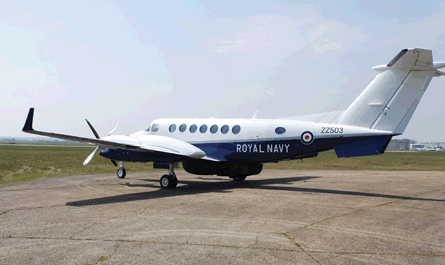 |
|---|
© CobhamAscent's training courses will use Hawker Beechcraft King Air 350ERs for the Royal Navy |
Ascent has to have related ground-based training equipment and lesson courseware prepared by 1 March, when the first instructors - drawn from the Jetstream service - will start work on the new system. Next to enter operational use will be the RAF's Hawk T2 AJT. The type was acquired via a non-competitive process by the UK government in 2006, with its order intended to safeguard BAE's long-term ability to market it to international customers as the Hawk 128. A total of 28 of the aircraft will enter use with the RAF's 19 Sqn at the service's Valley training base in Anglesey, north Wales, under the programme. The value of production and development runs to more than £600 million ($966 million).
Following the platform choice and Ascent's selection to deliver MFTS in November 2006, the company has been responsible for ordering related training devices and overseeing the construction of facilities at Valley. The latter includes a new hangar to accommodate the fleet of aircraft, plus a "school house" and a separate building for its eventual two CAE-built full mission simulators (FMS). The first of these completed six weeks of factory acceptance testing in Montreal, Canada, in January, and "all the operators that have used it are impressed with the quality of the simulation", says Thornton. The device was shipped to the UK this year, while the second will enter factory tests in March.
"These FMSs will provide the majority of the training in the student operational scenarios, including simulation of synthetic radar, surface-to-air missile, air-to-air missile and decoy systems," says Ascent.
Six additional ground-based flight-training devices have been installed in the school house, along with desktop trainers. The first batch of six ground instructors has been approved, and the first students will arrive in November. The RAF will provide qualified flying instructors to deliver the flight instruction; they start their preparations in March.
Although visually similar to the RAF's legacy Hawk T1, the service's new AJT features next-generation capabilities that will better enable pilots to progress on to single-seat types such as the Eurofighter Typhoon and the Lockheed Martin F-35 Joint Strike Fighter.
Hawk T2 training will start using aircraft in an "OC2" software standard, with embedded-radar-simulation capability.
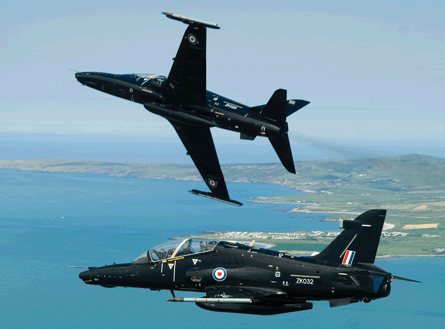 |
|---|
© Cpl Paul Oldfield/Crown CopyrightThe first students to train on the RAF's new Hawk T2 will fly the 19 Sqn aircraft in November |
BAE has already completed manufacturing work on the new Hawks, although several will be updated after being removed from storage. Production of the new AJT fleet got ahead of the rest of the MFTS programme as the MoD took until mid-2008 to sign its partnering deal with Ascent.
The process to select the providers for the UK's tri-service fixed- and rotary-wing military flying training needs has reached an advanced stage, with decisions due from late this year. The remaining aspects represent the vast bulk of the MFTS programme activity.
Leading the way is the search for the UK's future elementary, basic, and multi-engine fixed-wing training requirements. Outline solutions were submitted to Ascent early this year from three interested parties, following the release of a request for proposals in late 2010.
More detailed solutions will be submitted in March from the rival bidders: a BAE Systems-led team that includes Babcock Aerospace, Gama Aviation and Pilatus; Elbit Systems; and the Team C3 group, comprising Cobham Aviation Services, CAE UK and Cassidian Air Systems (see separate bidder entries).
REPLACE OR MODIFY
In their offers, the companies must outline how they will replace or modify much of the equipment in current use. Crucially, this includes the RAF's Shorts Tucano T1 basic trainers, which are now based at its Linton-on-Ouse site in Lincolnshire.
While basing decisions for MFTS have yet to be finalised, Ascent says the system's basic flying training aircraft is expected to be collocated at RAF Valley with the service's new Hawk T2s. Elementary flying and multi-engine pilot training is expected to continue from RAF Cranwell in Lincolnshire, it adds.
The process to also update the rotary-wing training inventory now in use at the Defence Helicopter Flying School (DHFS) at RAF Shawbury in Shropshire is running a few months behind the fixed-wing contest. On 14 January, two parties submitted responses to an Ascent RFP. Also issued late last year, this sought draft responses on factors such as the total number of flight hours and simulators required, and on related infrastructure.
Vying for the work are AgustaWestland; and the Alphar consortium formed of Eurocopter, CAE and FB Heliservices - the FR Aviation/Bristow Helicopters company that runs the UK's current DHFS service. With the contest entering a crucial stage, neither competitor has spoken about its possible platform solution for the requirement, which will replace the capabilities delivered using single-engined Eurocopter AS350 Squirrels and Bell Helicopter 412 twins. A final RFP is due for release next month.
Ascent expects helicopter training activities to continue to be centred at Shawbury, and also at the School of Army Aviation at Middle Wallop, Hampshire.
Decisions on both the fixed-wing and helicopter training services are expected in late 2011 or early 2012, with new equipment to enter use from around 2015. Each element could be worth approaching £1 billion over the life of the MFTS programme.
FLYING THROUGH THE SDSR
Announced last September, the outcome of the UK's Strategic Defence and Security Review (SDSR) caused much controversy.
After performing well in Afghanistan, the BAE Harrier GR9/9As of the RAF/RN Joint Force Harrier organisation were swiftly removed from service, and flew their last operational sorties before the year had ended.
Once combined with a planned reduction in the size of the RAF's Panavia Tornado GR4 combat force, the wider implications for the MFTS programme are profound. "The scale of the drop in the fast-jet pipeline is of the order of 40% in terms of student throughput," Thornton reveals.
Elsewhere, the decision to axe BAE's Nimrod MRA4 maritime patrol and surveillance aircraft removed a planned operational fleet of nine aircraft and multiple crews from long-term planning assumptions. As a result, the last training course using the RAF's Hawker Siddeley 125 Dominies concluded at Cranwell in January.
"The cancellation of the Nimrod MRA4 and a reduction in the number of Tornado GR4s has resulted in the RAF ceasing any further weapons system officer training," the service says. In all, the SDSR process and other rationalisation has removed around eight of the expected 33 individual course types originally to have been delivered through the MFTS programme.
A Dominie replacement was due to have been acquired through the rear-crew phase-two requirement, but because of the SDSR cuts, possible spare capacity could now be sought on the navy's new King Air 350ERs.
While the UK's frontline services are facing cuts, Thornton says: "We've got to constantly think about whether there will be a long-term requirement to create more capacity."
This could come via an increased number of pilots leaving the armed forces, or by an unexpected increase in equipment purchases.
Another potential means of gaining additional business would be by providing third-party training to international customers.
Under the terms of its contract, Ascent is not funded to provide any spare capacity on the UK's new training system, and Thornton says it has received no formal approaches with regard to potential export sales, such as of the Typhoon to Oman. "There are many ways of creating spare capacity, one of which is buying extra assets," he notes. "I see good opportunities for the model once we're up and running. We'd be very happy to export the MFTS model more widely around the world."
THE BIDDERS
BAE OPTS FOR LOW RISK AND INNOVATION
Of the three contenders for the fixed-wing service provision deal, the consortium led by BAE Systems is the only one to have revealed its proposal.
Teamed with Babcock Aerospace, Gama Aviation and Pilatus, BAE is offering what it describes as "a low-risk, innovative aircraft availability service". Its proposal hinges on a digital cockpit upgrade for the UK's Grob 115 Tutors, plus the provision of two new aircraft types for the Royal Air Force.
"Gama will lead all aspects of the multi-engine elements of the proposal, including platform selection and an optimised through-life support service," says the business aviation service company. Its choice is of the Cessna Citation Mustang.
 |
|---|
© Katsuhiko Tokunaga/PilatusThe trainer's cockpit would be optimised for the Hawk T2 |
For the basic trainer requirement, the team is offering the Pilatus PC-21 turboprop. With its high-speed performance, the type is already being used to train pilots for frontline operations with the Swiss air force's Boeing F/A-18C/Ds; removing altogether the use of an advanced jet trainer. Singapore is using the type as a stepping stone to its Boeing F-15SGs and Lockheed Martin F-16s, but late last year signed a production deal to also acquire Alenia Aermacchi's M-346 advanced jet trainer.
For the UK opportunity, the PC-21 is being offered with a cockpit optimised for the RAF's Hawk T2, says BAE.
In a 2008 report, Flight International test pilot Peter Collins described the PC-21 as "a delight to fly in all regimes". The type would serve well as a complement to a dedicated lead-in fighter trainer, or in preparing pilots to transition straight onto a frontline combat aircraft, Collins said. "Within a few minutes I believed that I was operating and fighting in the F/A-18 that the cockpit customisation was designed to replicate."
ELBIT PUTS ITSELF FORWARD
Israel's Elbit Systems has declined to provide any details about its draft fixed-wing proposal at this stage of the competitive process, or to reveal its potential partners in delivering a service to the UK.
But the elementary training aspect of its proposal could include an upgrade to the RAF's current Grob 115 Tutor fleet, with Elbit having previously displayed a cockpit design with replacement avionics. The firm has also joined up with Grob Aircraft to offer the new-generation G120TP turboprop to international users. "Elbit Systems has gained lots of experience in pilot training and in conducting private finance initiative and 'power by-the-hour' projects for many years," the company says.
In Israel, it has established services using G120A aircraft, Hawker Beechraft King Air 200s and T-6A trainers, as well as providing related equipment including simulators and maintenance support.
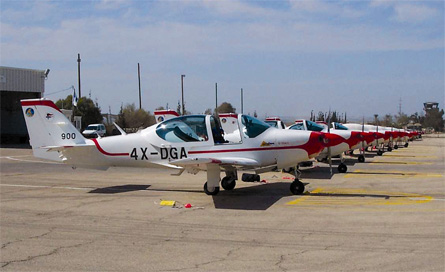 |
|---|
© Elbit Systems |
Elbit already provides G120A 'Snunit' trainers for the Israeli air force |
The company has also teamed up with Israel Aerospace Industries in offering to provide either the Alenia Aermacchi M-346 or Korea Aerospace Industries/Lockheed Martin T-50 to meet the Israeli air force's long-term requirement for a new fleet of advanced jet trainers.
Elbit is no stranger to the UK market, where it already has an industrial footprint through its part in the U-TacS joint venture with Thales.
The company will deliver the British Army's Watchkeeper unmanned air vehicle capability, and already provides interim surveillance cover in Afghanistan using a fleet of Elbit's Hermes 450 UAVs.
TEAM C3 PUTS ITS FAITH IN LATEST VERSION OF T-6
Cobham Aviation Services, CAE UK and EADS company Cassidian Air Systems form the Team C3 consortium, which is also pursuing the remaining fixed-wing elements of the Military Flying Training System programme.
Only one part of the group's proposal has been confirmed to date, with its basic flying training offer being based on the use of Hawker Beechcraft's T-6C. The latest version of a design that is already in use with the US Air Force and US Navy, and with international operators Canada, Greece, Iraq, Israel and Morocco, the turboprop comes with a strong track record.
The type's manufacturer has handed over more than 600 "Texan IIs", with Morocco having recently taken delivery of the first C-model examples. More than 70 aircraft are assembled each year at Wichita, Kansas, but this could rise to 96 using existing tooling.
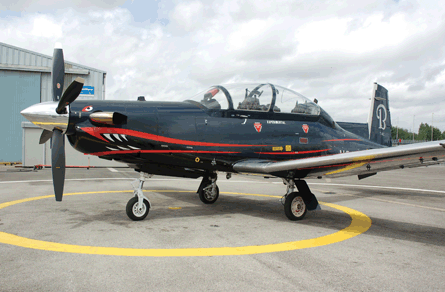 |
|---|
© Craig Hoyle/FlightglobalThe T-6C hails from a product line with more than 600 deliveries |
Hawker Beechcraft business development executive government business Nigel Guz highlights the long-term assurance offered to international operators by the US commitment to the T-6. "We have production booked to 2017 and a logistics plan to support the type out to 2050," he says. And with reference to the UK, he points to the successful use of the T-6A Harvard II as part of the Bombardier-run NATO Flying Training in Canada system in preparing pilots to fly BAE Systems' Hawk advanced jet trainer.
The US manufacturer and Cobham conducted in-country flight demonstrations with T-6C development aircraft N3000B in the UK ahead of last year's Farnborough air show, and defence editor Craig Hoyle was invited to fly in the turboprop.
Chief pilot government business J D O'Malley demonstrated the aircraft's easy and unsupported ground start-up procedure. "The goal is to get the student up in the air as soon as possible," he says. "You're not doing much training sitting on the ground."
Hoyle got the chance to experience the T-6C's handling characteristics during a more than 1h sortie, and to control manouevres including stall and spin recoveries. Also demonstrated were simulated weapons capabilities developed for the USN, including a bomb release scoring system and an air-to-air combat mode using a simulated cannon.
During the flight, he was also able to experience the aircraft's uncluttered cockpit layout, which from the rear seat includes three 5x7in multi-function displays and hands-on-throttle-and-stick controls.
Cobham has also recently modified four King Air 350ERs to meet the Royal Navy's observer training requirements.
THE TUCANO ALTERNATIVE
In addition to the proposals to be put forward to Ascent Flight Training next month by the three fixed-wing bidding teams, the Ministry of Defence also has a possible alternative option to meet its basic flying-training needs in the light of the force restrictions imposed via the UK government's Strategic Defence and Security Review (SDSR).
In the middle of the last decade, the ministry funded Bombardier (Shorts) to complete a proof of concept study into a potential upgrade for some of the Royal Air Force's Tucano T1 trainers, with the effort supported by Marshall Aerospace.
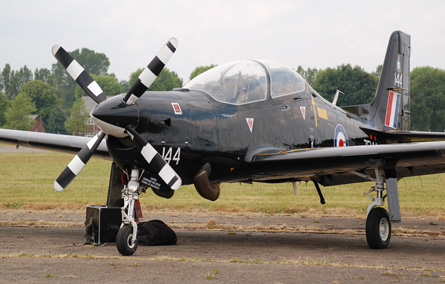 |
|---|
© Craig Hoyle/Flightglobal |
The work led to the production of a cockpit demonstrator which was funded and developed by the two companies and displayed at the 2008 Farnborough air show.
Key features of the design included a CMC-supplied glass cockpit and replacement mission computers, plus a proposal to increase engine performance by around 10%.
Marshall Aerospace briefed Peter Luff, the UK minister for defence equipment, support and technology, about the Tucano enhancement study during his visit to its Cambridge airport site early this year. "The MoD is not pursuing any unnecessary modifications to Tucano beyond those deemed essential to achieve the current out-of-service date," the company says.
However, "should the current [Military Flying Training System] competition structure change because of the significantly reduced pilot training requirements post-SDSR, the Tucano upgrade might address the basic flying training requirement as a cost-effective option," it adds.
"The extent of an upgraded modification would be based on previous design work," it says, "but tailored to only essential enhancements, given the short- to medium-term intent of such a course."
Source: Flight International



















